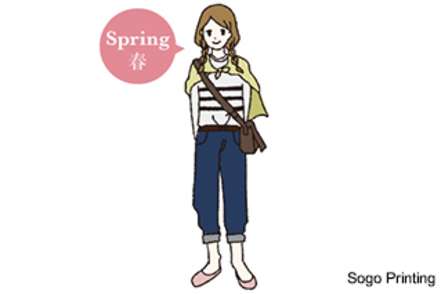
GUIDE The climate in Hokkaido(Tips for what to wear) by JNTO on 19 January 2019
Japan is a vertically long country, and as such, it experiences a number of different climates. The northernmost prefecture of Hokkaido is a subarctic zone while the southernmost Okinawa islands experience a more tropical climate.
Situated about 800 kilometers north of Tokyo, Sapporo (the major town in Hokkaido) is actually located at almost the same latitude as Vladivostok in Russia, so while its summers are pleasantly cooler than the rest of Japan (around 26.4ºC), winters can be a bit severe since temperatures can drop to -7ºC with heavy snowfall, so it’s necessary to bring heavy winter clothing and sturdy boots when visiting during this season.

The best way to plan your outfit is to regularly check the weather forecast no matter what season it is since the weather can change instantly.
Spring (March to May)
Temperature: -3ºC to 17ºC
Signs of spring may start in March, but it is still cold with temperatures around 0ºC. With the weather warming up, the snow is usually gone by April although ski season in the mountains may last till May. By April and May, the cold nights give way to warmer daytime temperatures (around 15ºC) with a high chance of rain which kickstarts the sakura season between late April to May, about a month later than most of Japan.

What to wear: During this season, it’s best to prepare yourself with winter accessories (gloves, beanies, scarves), and dress in layers – bring extra jackets or sweaters – because the temperatures can fluctuate wildly, not just between night and day. As the weather gets warmer, the snow begins to melt, so you should also pack waterproof boots and rain gear, since there is also a high chance of rain.
Summer (June to August)
Temperature: 13ºC to 27ºC
June brings with it a comfortable average temperature of 20ºC – but the weather can change quite quickly, since you can still feel the effects from the cold winds from the north, in addition to the increased chances of rainstorms. July to August is the summer period when daytime temperatures can exceed 30ºC, but the lower humidity compared to the rest of Japan makes it bearable. Temperatures are generally lower at nighttime, as well as in some coastal areas.

What to wear: Since it’s warmer, you can wear short-sleeved tops but bring light jackets, hoodies, or sweaters for when the temperature dips at night. As the sun can be intense, sunglasses, hats, and sunscreen should be on your packing list. Be prepared for rain if you plan on visiting in June.
Fall/Autumn (September to November)
Temperature: 7ºC to 22ºC
By mid-September, the temperature begins to dip, and by October, Hokkaido goes through the koyo season when leaves turn into hues of red and yellow – a month earlier than the rest of Japan. November marks the transition between the end of the koyo season and the first snowfall of the winter season (especially in the mountains) in the whole of Japan.

What to wear: Similar to spring weather, the temperatures can fluctuate, so be prepared. In addition to long sleeves, you’ll need to bring sweaters or coats when outdoors; if visiting in November, bring winter jackets in addition to accessories like scarves, beanies, and gloves. As there could be snowfall, a sturdy pair of winter boots would be ideal to get around with.
Winter (December to February)
Temperature: -3ºC to -11ºC
The coldest time to be in Hokkaido is between January and February when the entire prefecture is blanketed in snow. This is the ideal condition for skiing, snowboarding, or other winter activities; in Sapporo it can drop to -7ºC, but in ski areas like Niseko, it can drop to -11ºC (-25ºC at the top of the mountain!). Don’t forget about windchill factor – depending on the intensity of the wind, you can feel as much as -10ºC colder.
The air is particularly dry in winter so it’s a good idea to pack moisturisers (and lip balm) if you’re normally used to tropical humidity.

What to wear: Layer your clothing (consider turtlenecks and fleece jackets for insulation) with as many items as you feel comfortable so you can adjust your comfort level when moving in and out of buildings.
It’s necessary to wear a winter jacket that offers wind protection; puffy down jackets are ideal for walks but may be too hot if you plan on skiing/snowboarding. Consider getting a pair of fleece-lined snow pants if you’re not used to the cold.
Always wear a pair of sturdy padded boots since you’ll mostly be walking on snow. Other essentials include scarves, gloves, and beanies. If you’re still cold, get some heat packs that are available at any convenience store.
* Reference of illustration: Slow Life HOKKAIDO
















































